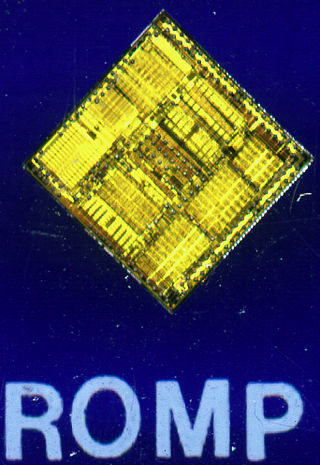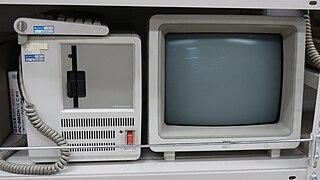Related Research Articles

ASCII art is a graphic design technique that uses computers for presentation and consists of pictures pieced together from the 95 printable characters defined by the ASCII Standard from 1963 and ASCII compliant character sets with proprietary extended characters. The term is also loosely used to refer to text-based visual art in general. ASCII art can be created with any text editor, and is often used with free-form languages. Most examples of ASCII art require a fixed-width font such as Courier for presentation.
Desktop publishing (DTP) is the creation of documents using dedicated software on a personal ("desktop") computer. It was first used almost exclusively for print publications, but now it also assists in the creation of various forms of online content. Desktop publishing software can generate page layouts and produce text and image content comparable to the simpler forms of traditional typography and printing. This technology allows individuals, businesses, and other organizations to self-publish a wide variety of content, from menus to magazines to books, without the expense of commercial printing.

A workstation is a special computer designed for technical or scientific applications. Intended primarily to be used by a single user, they are commonly connected to a local area network and run multi-user operating systems. The term workstation has been used loosely to refer to everything from a mainframe computer terminal to a PC connected to a network, but the most common form refers to the class of hardware offered by several current and defunct companies such as Sun Microsystems, Silicon Graphics, Apollo Computer, DEC, HP, NeXT, and IBM which powered the 3D computer graphics revolution of the late 1990s.

The IBM Series/1 is a 16-bit minicomputer, introduced in 1976, that in many respects competed with other minicomputers of the time, such as the PDP-11 from Digital Equipment Corporation and similar offerings from Data General and HP. The Series/1 was typically used to control and operate external electro-mechanical components while also allowing for primitive data storage and handling.

Typesetting is the composition of text for publication, display, or distribution by means of arranging physical type in mechanical systems or glyphs in digital systems representing characters. Stored types are retrieved and ordered according to a language's orthography for visual display. Typesetting requires one or more fonts. One significant effect of typesetting was that authorship of works could be spotted more easily, making it difficult for copiers who have not gained permission.

Wang Laboratories was a US computer company founded in 1951 by An Wang and G. Y. Chu. The company was successively headquartered in Cambridge, Massachusetts (1954–1963), Tewksbury, Massachusetts (1963–1976), and finally in Lowell, Massachusetts (1976–1997). At its peak in the 1980s, Wang Laboratories had annual revenues of US$3 billion and employed over 33,000 people. It was one of the leading companies during the time of the Massachusetts Miracle.

Ultrix is the brand name of Digital Equipment Corporation's (DEC) discontinued native Unix operating systems for the PDP-11, VAX, MicroVAX and DECstations.

A computer terminal is an electronic or electromechanical hardware device that can be used for entering data into, and transcribing data from, a computer or a computing system. Most early computers only had a front panel to input or display bits and had to be connected to a terminal to print or input text through a keyboard. Teleprinters were used as early-day hard-copy terminals and predated the use of a computer screen by decades. The computer would typically transmit a line of data which would be printed on paper, and accept a line of data from a keyboard over a serial or other interface. Starting in the mid-1970s with microcomputers such as the Sphere 1, Sol-20, and Apple I, display circuitry and keyboards began to be integrated into personal and workstation computer systems, with the computer handling character generation and outputting to a CRT display such as a computer monitor or, sometimes, a consumer TV, but most larger computers continued to require terminals.

LocoScript is a word processing software package created by Locomotive Software and first released with the Amstrad PCW, a personal computer launched in 1985. Early versions of LocoScript were noted for combining a wide range of facilities with outstanding ease of use. This and the low price of the hardware made it one of the best-selling word processors of the late 1980s. Four major versions of LocoScript were published for the PCW, and two for IBM-compatible PCs running MS-DOS. LocoScript's market share didn't expand with the PC versions, which were not released until after Windows had become the dominant PC operating system.
Prime Computer, Inc. was a Natick, Massachusetts-based producer of minicomputers from 1972 until 1992. With the advent of PCs and the decline of the minicomputer industry, Prime was forced out of the market in the early 1990s, and by the end of 2010 the trademarks for both PRIME and PRIMOS no longer existed
NASTRAN is a finite element analysis (FEA) program that was originally developed for NASA in the late 1960s under United States government funding for the aerospace industry. The MacNeal-Schwendler Corporation (MSC) was one of the principal and original developers of the publicly available NASTRAN code. NASTRAN source code is integrated in a number of different software packages, which are distributed by a range of companies.

The IBM RT PC is a family of workstation computers from IBM introduced in 1986. These were the first commercial computers from IBM that were based on a reduced instruction set computer (RISC) architecture. The RT PC uses IBM's proprietary ROMP microprocessor, which commercialized technologies pioneered by IBM Research's 801 experimental minicomputer. The RT PC runs three operating systems: AIX, the Academic Operating System (AOS), and Pick.

The ROMP is a reduced instruction set computer (RISC) microprocessor designed by IBM in the late 1970s. It is also known as the Research OPD Miniprocessor and 032. The ROMP was originally developed for office equipment and small computers, intended as a follow-on to the mid-1970s IBM OPD Mini Processor microprocessor, which was used in the IBM Office System/6 word-processing system. The first examples became available in 1981, and it was first used commercially in the IBM RT PC announced in January 1986. For a time, the RT PC was planned to be a personal computer, with ROMP replacing the Intel 8088 found in the IBM Personal Computer. However, the RT PC was later repositioned as an engineering and scientific workstation computer. A later CMOS version of the ROMP was first used in the coprocessor board for the IBM 6152 Academic System introduced in 1988, and it later appeared in some models of the RT PC.

The IBM 6580 Displaywriter System is a 16-bit microcomputer that was marketed and sold by IBM's Office Products Division primarily as a word processor. Announced on June 17, 1980 and effectively withdrawn from marketing on July 2, 1986, the system was sold with a 5 MHz Intel 8086, 128 KB to 448 KB of RAM, a swivel-mounted monochrome CRT monitor, a detached keyboard, a detached 8" floppy disk drive enclosure with one or two drives, and a detached daisy wheel printer, or Selectric typewriter printer. The primary operating system for the Displaywriter is IBM's internally developed word processing software titled "Textpack", but UCSD p-System, CP/M-86, and MS-DOS were also offered by IBM, Digital Research, and CompuSystems, respectively.
MSC Software Corporation is an American simulation software technology company based in Newport Beach, California, that specializes in simulation software.
During the Killian documents controversy in 2004, the authenticity of the documents themselves was disputed by a variety of individuals and groups. Proof of authenticity is not possible without original documents, and since CBS used only faxed and photocopied duplicates, authentication to professional standards would be impossible regardless of the provenance of the originals. However, proving documents inauthentic does not depend on the availability of originals, and the validity of these photocopied documents has been challenged on a number of grounds, ranging from anachronisms in their typography to issues pertaining to their content.
Lotus Manuscript is a discontinued MS-DOS-based word processor from Lotus Development first released in 1986. The software was distributed on eight 5¼" diskettes and retailed for US$495.

The AT&T UNIX PC is a Unix desktop computer originally developed by Convergent Technologies, and marketed by AT&T Information Systems in the mid- to late-1980s. The system was codenamed "Safari 4" and is also known as the PC 7300, and often dubbed the "3B1". Despite the latter name, the system had little in common with AT&T's line of 3B series computers. The system was tailored for use as a productivity tool in office environments and as an electronic communication center.

IBM 5550 is a personal computer series that IBM marketed in Japan, Korea, Taiwan and China in the 1980s and 1990s, for business use customers. In Japan, it was introduced in 1983 and promoted as "Multistation 5550 (マルチステーション5550)" because it had three roles in one machine: a PC, a word processing machine which was traditionally marketed as a machine different from a PC in Japan, and an IBM-host attached terminal.
The ICL DRS was a range of departmental computers from International Computers Limited (ICL). Standing originally for Distributed Resource System, the full name was later dropped in favour of the abbreviation.
References
- ↑ The name on the software distribution media, (C) 1983, 1986 by MARC Software International, Inc
- ↑ "The Executive Computer". The New York Times . June 21, 1987.
... WordMARC Composer ... WordPerfect
- ↑ "MARC Software fonts". PC Magazine. January 28, 1986. p. 125.
MARC Software ... creating scientific or mathematical characters within these fonts ...
- 1 2 "Macneal-Schwendler to buy MARC Analysis Research". The New York Times. May 29, 1999.
- ↑ "MARC Software International". July 1986.
Pedro V. Marcal President MARC Software International Inc. Palo Alto
- ↑ "WordMarc Composer". 1988.
WordMarc Composer .. technical character .. handles scientific and technical text so well.
- ↑ "WordMarc release for Ultrix adds X Window support". Archived from the original on 2018-11-13.
- ↑ "WordMARC Word Processing". annals.org (Annals of Internal Medicine). May 1, 1985.
WordMARC ... formerly known as MUSE
- ↑ E. P. Palmer (1986). "Experiments in cold fusion".
... reports and manuals, ... WordMARC ... formatting
- ↑ "Unix WordMARC supporting Postscript". February 16, 1987.
Unix-Based Wordmarc To Support Postscript
- ↑ "MARC Analysis Research Corp". Bloomberg News .
- ↑ "Marc Analysis Research Corp". The Los Angeles Times. Archived from the original on December 9, 2015.